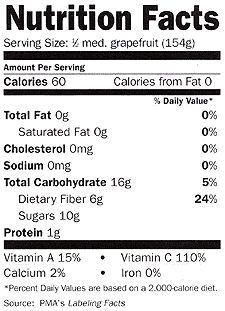

















MERCHANDISING
Displays
The basics: Grapefruit works well in bulk displays because it can be piled fairly high without damage to the fruit. When this is done, take care that displays are not too high and subject to collapse during consumer examination.
Grapefruit graphic bins are an excellent way to display bagged or bulk fruit. When promoting bagged and bulk fruit, use multiple pricing to encourage consumers to stock up.
Offer a choice – not only of sizes, but of bagged and bulk packaging and red and white varieties. Be sure to mark seedless varieties.
Display few grapefruit cut in half to attract consumers to the unusual reddish interior color.
Grapefruit often is used as a base for fruit baskets because it ships well.
Themes: Encourage customers with cross merchandising to serve grapefruit with a variety of toppings such as brown sugar, thinly sliced pepper rings, thin apple slices and strawberries. Also cross-merchandise with avocados for a tangy zing to avocado salads. Encourage consumers to add grapefruit to chicken salads.
Promotion
When white- and red-fleshed varieties are offered, be sure signs point out the differences.
Encourage consumers to peel or cut and section the fruit for breakfast.
Demonstrations are helpful in showing the difference between golden and ruby varieties.
Conduct regular sampling program to increase grapefruit sales.
Encourage consumers to use grapefruit slices instead of lemon in iced tea or water.
varieties/types
Reds
Henderson
Oct-May
Ray
Oct-May
Rio Red
Oct-May
Flame
Oct-May
Star Ruby
Year-round
Marsh Ruby
Year-round
White
Marsh Seedless
Year-round
Grapefruit is available year-round, peaking Jan-Apr with somewhat reduced supplies Jul-Sep. La., the top producer, and Texas provide the bulk of the winter crop. Ariz. And Calif. Produce the bulk of the spring and summer crops. (See also Or Blanco, Melogold and Pummelo)
Nutrition
In addition to providing grams and Daily Values, nutrient content descriptors can inform consumers if a nutrient level is considered high or low.
When using a nutrient content descriptor, Food and Drug Administration labeling laws state that the descriptor should be used as in this example: broccoli, a low-sodium food, or broccoli, low in sodium, etc. The statement low-sodium broccoli implies that the broccoli is different or specially prepared. Do not use that type of misleading statement.
Nutrient content descriptors allowed for grapefruit include: fat-free, saturated fat-free, sodium free, cholesterol-free, high in fiber, a good source of vitamin A and high in vitamin C.

Foodservice
Halved or wedged grapefruit is popular anytime, but particularly so at breakfast or on a salad bar.
Halved grapefruits are just asking for a topping. Top the sections with strawberries, brown sugar, pepper rings or honey.
Grapefruit is good in drinks, fruit salads and salad dressing. It also can be sautéed, made into jellies or marmalade.
For breakfast, layer grapefruit sections, strawberry yogurt and granola.
Juice squeezed from a fresh grapefruit makes tenderizing marinade for any meat.
Add shredded or grated grapefruit peel to sauces, salad dressings, fruit compotes, a glass of wine or champagne or decorate a sandwich tray or cake.
For grapefruit shells, halve a grapefruit crosswise. With a curved grapefruit knife or paring knife, carve away the fruit inside. Scrape the shell clean with a spoon. To prevent the shell from tipping, cut a thin slice from the bottom. The shells are good for salads, cold soups, beverages, dips or sauces and fruit compotes.
Grapefruit can be cut into twists or smiles for an appetizing garnish to any dish.
Back to top